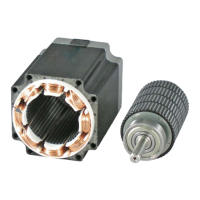November 4, 2009 13
User Interfaces
The Stepper RDK firmware provides control of the stepper motor. It makes use of many of the
features of the Stellaris microcontroller to perform the stepping function, reducing the number of
external parts needed. In addition, the stepping firmware can be integrated with the user’s
application, eliminating the need for separate microcontrollers for the stepping and application
functions.
The Stepper RDK firmware generates a stepping sequence as needed to run the motor at the
specified speed. It also computes acceleration and deceleration ramps to smoothly change the
motor speed between stopped and target speed. It switches voltage to the control signals of the
H-bridge in order to drive the correct current to the motor windings at each step in a stepping
sequence.
The Stepper RDK firmware can be controlled in two ways. The simplest way is using the on-board
interface, which allows the user control of the motor speed or position using controls available on
the RDK board. For more complex control, a PC-hosted graphical program is available which not
only allows setting of speed and position, but also a number of other parameters for tuning the
motor operation (see “Graphical User Interface” on page 15).
On-board User Interface
The on-board user interface provides a way for the user to operate the stepper motor using just the
controls provided on the stepper RDK board. The controls that can be used are a potentiometer, a
push button, and two LEDs. See Figure 2-1 for a photo of the on-board controls.
Figure 2-1. On-board User Interface
J T AG/SWD
Connector
PotentiometerUser Button
Mode LED
tatus LED
ower LED
Reset Button
CHAPTER 2

